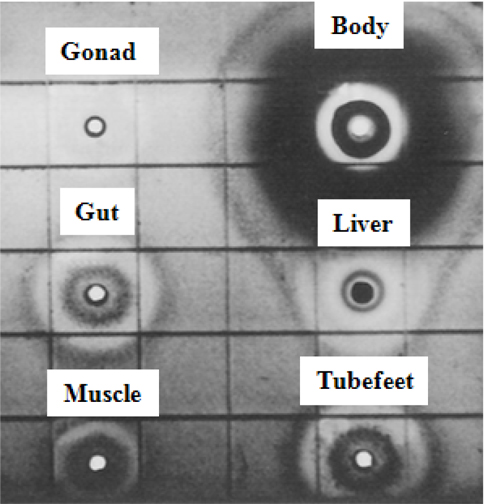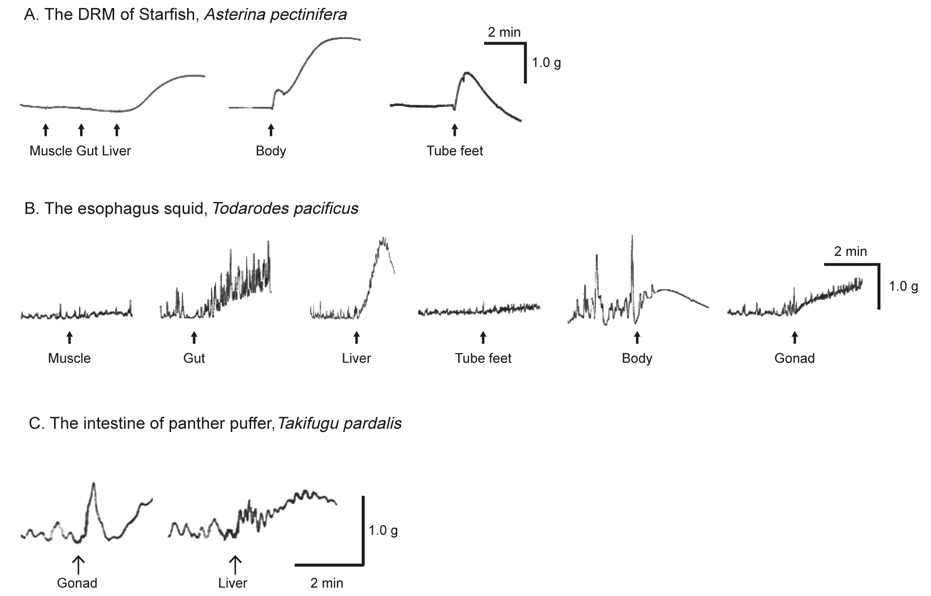



The present study was performed to examine the contraction and relaxation responses of the smooth muscles, and search for antimicrobial and antioxidant activities in the tissues, of the starfish
해양 척추동물 및 무척추동물로부터 많은 종류의 항균, 항곰팡이, 신경전달물질, 항산화 물질 등의 생리활성물질이 연구되고 있다(Donia and Hamann, 2003). 해양생물들은 수중에서 생활하기 때문에 육상생물보다 세균에 감염될 가능성이 더 크지만, 이들로부터 자기 자신들을 보호하기 위한 독특한 면역체계를 지니고 있다(Hancock and Diamond, 2000). 척추동물에는 선천면역(innate immunity)과 적응면역(adaptive immunity)이 각각 잘 발달되어 있지만 무척추동물에서는 선천면역이 중요한 역할을 담당하고 있다. 최근, 여러 가지의 선천면역 요소들 중에서 비특이적이고 빠른 반응성을 가지는 항균활성 펩타이드에 대한 관심이 증가되고 있다. 현재까지 무척추동물인 해면(Matsunaga et al, 1985), 담치(Charlet et al., 1996; Mitta et al., 1999; Mitta et al., 2000), 투구게(Miyata et al., 1989), 갯지렁이(Ovchinnikova et al., 2004), 군소(Iijima et al., 2003), 새우(Destoumieux et al., 1997), 성게(Li et al., 2008), 해파리(Ovchinnikova et al., 2006) 등에서 항균 펩타이드에 관한 연구가 보고되었다.
낙지로부터 신경전달물질인 eledosin이 발견된 이후(Erspamer and Anastasi, 1962) 다양한 생물의 조직으로부터 신경성 펩타이드(neuropeptides)가 발견되었다(Krieger, 1986). 신경성 펩타이드는 신호전달물질로 신경계에서 신호전달 및 조절하는 역할을 하며(Elliott and Barchas, 1979; Krieger, 1983), 평활근의 운동조절, 혈관의 수축 및 이완, 통증전달 및 혈압 조절 등의 역할을 담당하고 있다(Zadina et al., 1986). 또한 이들 신경전달물질들은 두톱상어(Chauvet et al., 1994), 송어(Irwin and Wong, 1995), 오만둥이(Iwakiri et al., 1990), 대구(Jensen and Colon, 1992) 등 다양한 종류의 해양생물들로부터도 발견되었다.
한편, 항산화제는 식품첨가물 뿐만 아니라 노화억제와 질병치료제로 사용되고 있다(Ames et al., 1993; Rice-Evans and Miller, 1996). 대표적인 항산화제로, tert-butylhydroxytoluene (BHT), tert-butylhydroxyanisol (BHA) 등의 합성 항산화제와 α-tocopherol, vitamin C, carotenoids, flavonoids 등의 천연 항산화제가 있으나, 보다 더 안전하면서 활성이 높은 항산화제를 천연물로부터 탐색하는 연구가 활발하게 진행되고 있다(Kang et al., 2003; Kim et al., 1997; Koshino et al., 1996; Park et al., 1991). 또한 정어리와 조기 껍질 가수분해물(Sampath Kumar NS et al., 2012), 틸라피아의 효소 가수분해물 (Fan et al., 2012)로부터 항산화 펩타이드가 정제되었으며, 그 외 항산화 활성을 나타내는 mycosporin-like amino acids (MAAs)가 존재함이 보고되었다(Dunlap and Yamamoto, 1995).
최근, 불가사리 추출물을 이용하여 유용한 생리활성에 대한 탐색에 관한 연구가 이루어지고 있다. 아무르 불가사리(
실험에 사용한 별 불가사리(
Tryptic soy broth (TSB), yeast extract, tryptone (Pancreatic digest of casein), agarose (Low EEO), acetylcholine chloride, carbachol 및 1,1-diphenyl-2-picrylhydrazyl (DPPH)는 Sigma사 (St. Louis, USA)에서 구입하였다.
별 불가사리(
각각의 조직에 대한 추출물의 항균활성은 ultra radial diffusion assay (URDA)법으로 항균활성을 측정하였다(Lehrer et al., 1991). 실험에 사용한 균주는 North Carolina State University의 Edward J. Noga 교수로부터 분양 받은 그람음성균인
>
별 불가사리 dorsal retractor muscle (DRM)에서의 수축 및 이완 활성 측정
별 불가사리의 eye spot을 제거한 후 배면과 복면을 분리하여 5개 팔을 따라 중앙을 가로지르는 DRM을 mess로 분리하여 20 mm정도의 단편으로 만들었다. 준비된 각 단편들은 반응조의 지지대에 고정시키고, 위쪽은 isometric transducer (NEC-Sanei, Tokyo, Japan)에 연결하여 resting tension이 1.0 g이 되도록 90분간 평형화 시켰다. 수축활성을 측정하기 위해, 별 불가사리 DRM 조직의 tension이 1.0 g이 유지되면 acetylcholine (ACh) 10-4 M 을 투여하여 활성화시켰다. 불가사리 조직 추출물들은 추출물의 총 부피의 1/10을 사용하여 인공해수에 녹인 후 반응조에 투여하여 활성을 확인하였다. 수축활성은 ACh에 대한 장관의 수축반응을 100%로 하고, 추출물에 대한 장관의 반응 정도는 ACh반응의 크기와 비교하여 나타내었다.
한편 각 조직 추출물의 이완활성을 측정하기 위해서, 조직의 tension이 1.0 g이 유지되면 10-4 M ACh을 투여하여 활성화 시켰고, 15분 후 10-4 M ACh을 투여하여 근육을 수축시킨 후, 조직 추출물을 반응조에 투여하여 이완활성을 확인하였다. 이완활성은 10-4 M Ach의 최대수축작용을 100%로 하여 상대적 이완 %로서 나타냈다. 모든 과정은 55 mM Mg2+ 인공해수에서 행하였으며, ASW의 조성은 다음과 같다: MgCl2.6H2O 55 mM, NaCl 445 mM, KCl 10 mM, CaCl2.2H2O 10 mM, Glucose 10 mM, Tris-HCl 10 mM (pH 7.8).
오징어를 반으로 갈라 뇌 아래에서부터 간의 뒤로 이어지는 소화관의 중앙부분을 약 7 cm를 떼어내어 지방 등을 제거한 후, 소화관의 길이가 약 1.0 cm 단편으로 만들어 활성 측정에 사용하였다. 모든 과정은 buffer에서 행하였으며, buffer의 조성은 다음과 같다: NaCl 466 mM, MgCl2 54 mM, CaCl2 11mM, KCl 10 mM, NaHCO3 3 mM, Na-HEPES 10 mM. 준비된 식도의 아래쪽은 2 mL의 반응조에 고정시키고 위쪽은 physiography system (NECSanei, Tokyo, Japan)의 isometric transducer에 연결하여 1.5 g의 장력을 준 뒤, 15분 간격으로 완충용액을 교체하면서 60분간 평형화하였다. 수축활성 측정은 실온에서 반응조 내에 공기를 주입시켜 주면서 안정화시킨 후 10-5 M carbachol (Carb)을 15분 간격으로 3회 투여하여 조직을 활성화 시켰다. 각 추출물은 총 부피의 1/10을 사용하여 반응조에 주입한 후 수축활성을 측정하여 physiography상에 기록하였다.
졸복 장관표본을 만들기 위해 먼저 중추신경을 절단하여 복부를 절개한 후, 항문으로부터 1 cm 정도 위쪽 부분의 장관을 약 2.0 - 3.0 cm 길이로 적출하였다. 모세혈관 및 지방 등을 제거한 후, 장관의 길이가 약 1.0 cm가 되도록 단편을 만들었다. 이 과정은 buffer상에서 행하였으며, buffer의 조성은 다음과 같다: NaCl 165 mM, KCl 3 mM, MgSO4∙7H2O 1.25 mM, NaHCO3 2 mM, CaCl2.2H2O 1.5 mM, Glucose 10 mM (pH 7.4). 준비된 장관표본은 2 mL의 반응조에 고정시키고 위쪽은 physiography system의 isometric transducer에 연결하여 1.5 g의 장력을 준 뒤, 15분 간격으로 완충용액을 교체하면서 60분간 평형화 시켰다. 수축활성 측정은 실온에서 반응조에 공기를 주입시켜 주면서 안정화시킨 후 10-7 M ACh을 15분 간격으로 3회 투여하여 조직을 활성화하였다. 각 추출물은 총 부피의 1/10을 사용하여 반응조에 투여하였다. 시료들은 주입한 후 수축활성을 측정하여 physiography상에 기록하였다. 수축활성은 10-7 M ACh에 의해 유도된 근육의 수축반응을 100%로 하고, 각 추출물에 대한 장관의 반응 정도는 ACh반응의 크기와 비교하여 나타내었다.
DPPH는 methanol에 녹여 1.5×10-4 M이 되도록 준비하였으며, 각각의 추출물들은 3 mg을 취하여 0.01% 초산용액 1 mL에 녹인 후, 그 중 1/50씩을 사용하여 활성을 측정하였다. 1 mL DPPH solution과 추출물을 UV cuvette에서 혼합하여 즉시 520 nm에서 흡광도를 측정하였다. 대조군(control)으로 1 mL DPPH 용액에 4 mL methanol을 혼합한 것을 사용하였다. DPPH radical 소거능(%)은 다음식으로 계산하였다.
DPPH radical 소거능(%) = [(O.D. of Control - O.D. of Sample)/O.D. of Control] × 100
모든 실험은 3회 반복한 평균치로 나타내었으며, 유의성 검증은 GraphPad Prism 5.0 for Window를 사용하여 ANOVA test로 검증한 후,
별 불가사리의 각 조직으로부터 추출한 추출물들의 항균활성을 조사하기 위해 그람음성균인
>
별 불가사리 DRM, 오징어 식도 및 졸복의 장관 평활근에 대한 수축 활성
별 불가사리 조직 추출물들의 근육 수축작용을 조사하기 위해서 별 불가사리 DRM을 사용하였으며, 10-4 M ACh에 의해 유도된 근육의 수축반응을 100%로 하고, 추출물에 대한 장관의 반응 정도는 ACh 반응의 크기와 비교하여 나타내었다. Table 1은 별 불가사리 DRM에 대한 조직 추출물의 근 수축 반응을 나타낸다. 간, 관족, 껍질 추출물들은 DRM에 대해 수축반응을 나타냈다. 특히, 껍질추출물의 경우, 100%의 강한 수축력을 보였으며, 간 추출물은 약 80%의 수축반응을 나타냈다. 한편, 관족 추출물은 수축활성을 나타내다가 동시에 이완활성을 보였다. 그러나 근육과 장관 추출물들은 수축반응을 보이지 않았다.
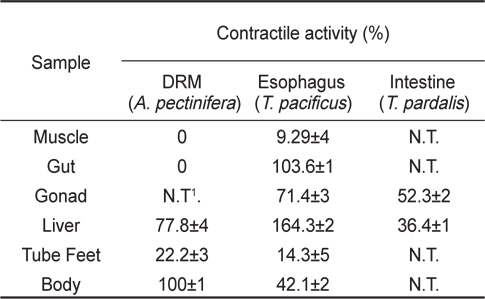
The contractile activity of various tissues' extracts of the starfish Asterina pectinifera on the smooth muscle of the other organisms (n=3)
오징어에 식도에 대한 각 추출물의 근 수축활성은 Fig. 2B 과 Table 1에 나타낸 바와 같이 10-5 M Carb에 의해 유도된 근육의 수축반응을 100%로 하고, 각 추출물에 대한 장관의 반응 정도는 Carb 반응의 크기와 비교하여 나타내었다. 별 불가사리 간(164.3%) 및 장관(103.6%) 추출물들은 매우 높은 수축반응을 나타냈으며, 생식선(71.4%) 추출물 또한 비교적 높은 반응을 나타내었다. 껍질과 관족 및 근육은 수축활성을 나타내었지만 다른 조직들에 비해서는 낮은 반응을 나타내었다. 특히, 껍질 추출물은 오징어 식도 평활근에 대해 수축활성의 톤은 증가시켰지만, 자율운동의 상동성 수축(phasic contraction)은 나타나지 않는 활성을 보였다(Fig. 2A, Table 1). 한편, 졸복의 장관에 대해 생식선 추출물은 졸복 장관의 자율운동의 진폭(amplitude)를 저하시키는 반면 높이(tone)의 증가를 유도하였으며, 간 추출물은 진폭과 높이의 증가를 관찰할 수 있었다(Fig. 2C).
불가사리 DRM에 대한 각 추출물의 이완활성은 Fig. 3과 Table 2에 나타내었다. Table 2에서 나타낸 바와 같이 근육 추출물은 41.4%의 이완활성을 나타내었으며, 소화관은 92.1%, 생식선은 76.8%, 간은 78.9%, 관족의 경우는 62.5%의 이완 활성을 보였다. 반면, 껍질 추출물의 경우, 다른 조직 추출물과는 달리 ACh에 의해 나타난 근 수축에 대한 이완활성을 나타내지 않고 더 강력한 수축 활성을 나타내었다(Fig. 3).
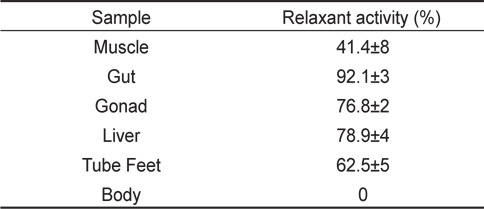
Relaxant activity of various tissues' extracts on the starfish Asterina pectinifera DRM (n=3)
근육에 대해 수축, 이완 활성을 지닌 신경성 펩타이드에 대한 연구로 극피동물인 해삼(
불가사리 조직 추출물들의 항산화 활성을 알아보기 위해서 DPPH를 사용하여 DPPH radical 소거능을 조사하였다. 항산화 활성 측정에 대한 대조구로 Vitamin C를 0.8, 4, 20, 100 및 500 μg/mL 사용하였으며, DPPH radical 소거능은 각각 13, 19, 60, 88 및 90%를 나타냈다(data not shown).
Table 3은 별 불가사리 조직들의 추출물에 대한 DPPH radical 소거능을 지표로 한 항산화 활성을 나타낸 것이다. 별 불가사리의 경우 소화관은 95.8±2%, 생식선은 100±1%, 간은 97.3±2%, 관족은 67.3±3%의 활성을 나타내었으며, 껍질의 경우, 100±1%의 반응을 나타내었다. 그러나, 근육의 경우는 다른 조직들에 비교적 약한 27.2% 정도의 항산화 효과를 나타내었다. 최근, 아무르 불가사리(
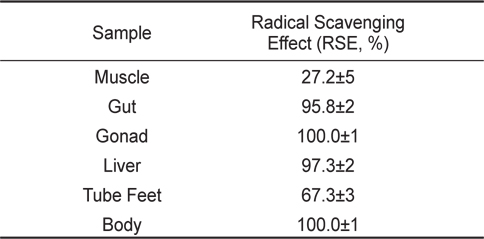
In vitro DPPH radical scavenging activities of various tissues’ extracts of the starfish Asterina pectinifera (n=3)


